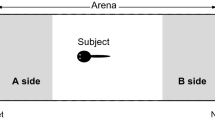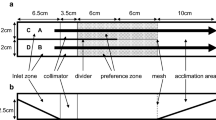Abstract
Ontogenetic changes in kin-recognition behavior, effect of social environment on kin-recognition ability, and use of visual and chemical cues in kin recognition have been studied in tadpoles of Bufo scaber after rearing them with kin, in mixed groups, or in isolation from Gosner stage 12 (gastrula). By use of a rectangular choice tank the tadpoles were tested for their ability to choose between (a) familiar siblings and unfamiliar non-siblings, (b) unfamiliar siblings and familiar non-siblings, and (c) unfamiliar siblings and unfamiliar non-siblings. When tested without any stimulus groups in the end compartments of the tank, random distribution was observed for the tadpoles and no bias for the apparatus or the procedure. In the presence of kin and non-kin in the end compartments, significantly more tadpoles spent most of their time near kin (familiar or unfamiliar) rather than near non-kin during early larval stages, up to stage 37. After stage 37 (characterized by the differentiation of toes), test tadpoles showed no preference to associate with kin, suggesting an ontogenetic shift in the kin-recognition ability in B. scaber. In experiments involving selective blockade of visual or chemical cues the test tadpoles preferentially associated near their kin on the basis of chemical rather than visual cues. These findings suggest that familiarity with siblings is not necessary for kin recognition and that kin-recognition ability is not modified after exposure to non-kin by mixed rearing. The findings for B. scaber indicate a “self referent phenotype matching” mechanism of kin recognition which is predominantly aided by chemical rather than visual cues.


Similar content being viewed by others
References
Beecher MD (1988) Kin recognition in birds. Behav Genet 18:465–482
Beecher MD (1991) Successes and failures of parent-offspring recognition in animals. In: Hepper PG (ed) Kin recognition. Cambridge University Press, Cambridge, pp 94–124
Blaustein AR (1983) Kin Recognition mechanisms: Matching or recognition alleles. Am Nat 121:749–754
Blaustein AR, O’Hara RK (1981) Genetic control for sibling recognition? Nature 290:246–248
Blaustein AR, O’Hara RK (1982) Kin recognition cues in Rana cascadae tadpoles. Behav Neural Biol 36:77–87
Blaustein AR, O’Hara RK (1986) An investigation of kin recognition in red-legged frog (Rana aurora) tadpoles. J Zool (London) 209:347–353
Blaustein AR, O’Hara RK, Olson DH (1984) Kin preference behavior is present after metamorphosis in Rana cascade frogs. Anim Behav 32:445–450
Blaustein AR, Waldman B (1992) Kin recognition in anuran amphibian larvae. Anim Behav 44:207–221
Blaustein AR, Bekoff M, Byers JA, Daniels TJ (1991) Kin recognition in vertebrates: What do we really know about adaptive value? Anim Behav 41:1079–1083
Blaustein AR, Tomoko Y, Kazue A, Walls SC (1993) Ontogenetic shifts in tadpole kin recognition- loss of signal and perception. Anim Behav 46:525–538
Cornell JT, Berven KA, Gamboa GJ (1989) Kin recognition by tadpoles and froglets of the wood frog Rana sylvatica. Oecologia 78:312–316
Fishwild TG, Schemidt RA, Jankens KM, Berven KA, Gamboa GJ, Richards CM (1990) Sibling recognition by larval frogs (Rana pipiens, Rana sylvatica and Pseudacris crucifer). J Herpetol 24:40–44
Fletcher DJC, Michener CD (1987) Kin recognition in animals. John Wiley and sons Ltd
Foster MC, McDiarmid RW (1982) Study of aggregative behavior of Rhinophrynus dorsalis tadpoles: Design and analysis. Herpetologica 38:395–405
Gamboa GJ, Berven KA, Schemidt RA, Fishwild TJ, Jankens KM (1991) Kin recognition in larval wood frogs (Rana sylvatica) effects of diet and prior exposure to conspecifics. Oecologia 86:319–324
Girish S, Saidapur SK (1999) The effects of kinship and density on growth and metamorphosis of the bronze frog (Rana temporalis) tadpoles. Acta Ethol 2:61–66
Gosner KL (1960) A simplified table for staging anuran embryos and larvae with notes on identification. Herpetologica 16:183–190
Hamilton WD (1964) The genetical evolution of social behavior. J Theor Biol I and II 7:1–52
Hauber ME, Sherman PW. (2001). Self-referent phenotype matching: theoretical considerations and empirical evidence. Trends in NeuroSci 24:609–616
Holmes WG (2004) The early history of Hamiltonian-based research on kin recognition. Ann. Zool Fennici 41:691–711
Lacy RC, Sherman PW (1983) Kin recognition by phenotype matching. Am Nat 121:489–512
Mateo JM, Johnston RE (2000). Kin recognition and the ‘armpit effect’: evidence of self-referent phenotype matching. Proc R Soc Lond B 267:695–700
Mateo JM, Johnston RE (2003). Kin recognition by self-referent phenotype matching: weighing the evidence. Anim Cogn 6:73–76
O’Hara RK, Blaustein AR (1981) An investigation of sibling recognition in Rana cascade tadpoles. Anim Behav 29:1121–1126
O’Hara RK, Blaustein AR (1982) Kin preference behavior in Bufo boreas tadpoles. Behav Ecol and Sociobiol 11:43–49
O’Hara RK, Blaustein AR (1988) Hyla regilla and Rana pretiosa tadpoles fail to display kin-recognition behavior. Anim Behav 36:946–948
Pfennig DW, Sherman PW (1995) Kin Recognition. Sci Am 68–73
Rautio SA, Bura EA, Berven KA, Gamboa GJ (1991) Kin recognition in wood frog tadpoles (Rana sylvatica)- factors affecting spatial proximity to siblings. Can J Zool 69:2569–2571
Saidapur SK, Girish S (2000) The ontogeny of kin recognition in tadpoles of the toad Bufo melanostictus (Anura; Bufonidae). J Biosci 25:267–273
Saidapur SK, Girish S (2001) Growth and metamorphosis of Bufo melanostictus tadpoles: Effects of kinship and density. J Herpetol 249–254
Sokal RR, Rohlf FJ (1995) Biometry. W. H. Freeman, San Francisco
Veeranagoudar DK, Shanbhag BA, Saidapur SK (2004) Mechanism of food detection in the tadpoles of bronze frog Rana temporalis. Acta Ethol 7:37–41
Waldman B (1981) Sibling recognition in toad tadpoles: The role of experience. Z Tierpsychol 56:341–358
Waldman B (1986) Chemical ecology of kin recognition in anuran amphibians. In: Duval D, Mϋller-Schwarze D, Silverstein RM (eds) Chemical signals in vertebrates 4. Ecology, Evolution and Comparative biology. Plenum Press, New York, pp 225–242
Waldman B (1988) The ecology of kin recognition. Ann Rev Ecol Syst 19:543–571
Waldman B (1989) Do anuran larvae retain kin-recognition abilities following metamorphosis? Anim Behav 37:1055–1058
Waldman B (1991) Kin recognition in amphibians. In: Hepper PG (ed) Kin recognition. Cambridge University press, Cambridge, pp 162–219
Waldman B, Adler K (1979) Toad tadpoles associate preferentially with siblings. Nature 282:611–613
Walls SC (1991) Ontogenetic shifts in the recognition of siblings and neighbours by juvenile salamanders. Anim Behav 42:423–434
Wassersug RJ (1973) Aspects of social behavior in anuran larvae. In: Vial JL (ed) Evolutionary biology of anurans. University of Missouri Press, Columbia, pp 273–297
Acknowledgements
The work was supported by a grant from the Department of Science and Technology (SP/SO/C-29/2000), New Delhi awarded to SKS. DKV thanks the Council of Scientific and Industrial Research, New Delhi, for Senior Research Fellowship. SVM was supported by a University Research Studentship.
Author information
Authors and Affiliations
Corresponding author
About this article
Cite this article
Gramapurohit, N.P., Veeranagoudar, D.K., Mulkeegoudra, S.V. et al. Kin recognition in Bufo scaber tadpoles: ontogenetic changes and mechanism. J Ethol 24, 267–274 (2006). https://doi.org/10.1007/s10164-006-0194-6
Received:
Accepted:
Published:
Issue Date:
DOI: https://doi.org/10.1007/s10164-006-0194-6




